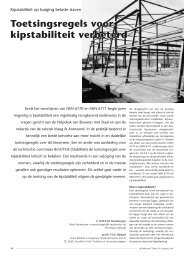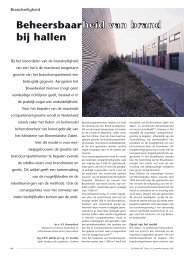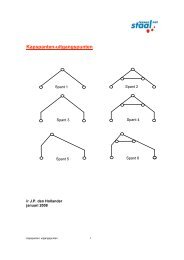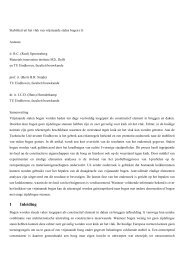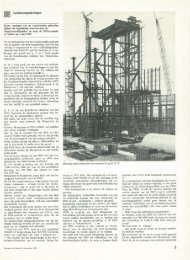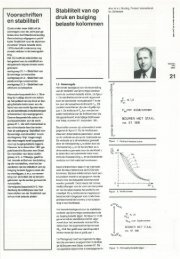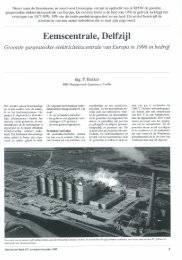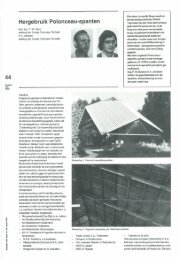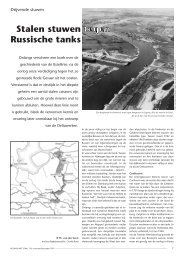- Page 1: NIEUWE BLIK OP KIP EN KNIK stabilit
- Page 4 and 5: Dit proefschrift is goedgekeurd doo
- Page 6 and 7: Waarover praatten zij, die elf daar
- Page 8 and 9: 8 Inleiding Deze studie is begonnen
- Page 10 and 11: 10 Inhoud 6 Analytische methode met
- Page 12 and 13: 12 Inhoud B7 Zijdelings gesteunde s
- Page 14 and 15: H 1 Samenvatting n * = 14 eindvervo
- Page 16 and 17: H 1 Samenvatting F M = v 16 z 2 Ez
- Page 18 and 19: H 1 Samenvatting Literatuur In de l
- Page 22 and 23: H 1a Summary F M = v 22 z 2 Ez k3 2
- Page 24 and 25: H 1a Summary References Many invest
- Page 26 and 27: H 2 Ontwikkeling stabiliteitsonderz
- Page 28 and 29: H 2 Ontwikkeling stabiliteitsonderz
- Page 30 and 31: H 3 Uitgangspunten figuur 3.2 De st
- Page 32 and 33: H 3 Uitgangspunten 3.2 Notaties en
- Page 34 and 35: H 3 Uitgangspunten spanningen: σ c
- Page 36 and 37: H 3 Uitgangspunten 3.3 Overige aann
- Page 38 and 39: H 3 Uitgangspunten 10. Als elke sta
- Page 40 and 41: H 4 Basisvergelijkingen en berekeni
- Page 42 and 43: H 4 Basisvergelijkingen en berekeni
- Page 44 and 45: H 4 Basisvergelijkingen en berekeni
- Page 46 and 47: H 4 Basisvergelijkingen en berekeni
- Page 48 and 49: H 4 Basisvergelijkingen en berekeni
- Page 50 and 51: H 4 Basisvergelijkingen en berekeni
- Page 52 and 53: H 5 Iteratiemethode De gedetailleer
- Page 54 and 55: H 5 Iteratiemethode 6 Uitbuiging va
- Page 56 and 57: H 5 Iteratiemethode 1 1 1 = + n nve
- Page 58 and 59: H 5 Iteratiemethode 58 figuur 5.6 O
- Page 60 and 61: H 5 Iteratiemethode 1 Vervorming: B
- Page 62 and 63: H 5 Iteratiemethode 62 6 Uitbuiging
- Page 64 and 65: H 5 Iteratiemethode 5.1.3 Staaf op
- Page 66 and 67: H 5 Iteratiemethode 66 figuur 5.16b
- Page 68 and 69: H 5 Iteratiemethode k = 0,73 en k 2
- Page 70 and 71:
H 5 Iteratiemethode Bij de meest vo
- Page 72 and 73:
H 5 Iteratiemethode figuur 5.23 Het
- Page 74 and 75:
H 5 Iteratiemethode F 74 Ez 2 π EI
- Page 76 and 77:
H 5 Iteratiemethode 76 2 Torsiemome
- Page 78 and 79:
H 5 Iteratiemethode 8 Gelijkvormigh
- Page 80 and 81:
H 5 Iteratiemethode 5.2.3 Uitkragin
- Page 82 and 83:
H 5 Iteratiemethode 4 2de -orde mom
- Page 84 and 85:
H 5 Iteratiemethode Vergelijkbaar m
- Page 86 and 87:
H 5 Iteratiemethode 86
- Page 88 and 89:
H 6 Analytische methode Uitwerking
- Page 90 and 91:
H 6 Analytische methode πx πx −
- Page 92 and 93:
H 6 Analytische methode ⎡ F ⎤
- Page 94 and 95:
H 6 Analytische methode Samenvatten
- Page 96 and 97:
H 6 Analytische methode M y1 = 2M y
- Page 98 and 99:
H 6 Analytische methode 6.2 Uitkrag
- Page 100 and 101:
H 6 Analytische methode figuur 6.1
- Page 102 and 103:
H 6 Analytische methode Als voorbee
- Page 104 and 105:
H 6 Analytische methode buiging: to
- Page 106 and 107:
H 7 Staven met zijdelings steunverb
- Page 108 and 109:
H 7 Staven met zijdelings steunverb
- Page 110 and 111:
H 7 Staven met zijdelings steunverb
- Page 112 and 113:
H 7 Staven met zijdelings steunverb
- Page 114 and 115:
H 7 Staven met zijdelings steunverb
- Page 116 and 117:
H 7 Staven met zijdelings steunverb
- Page 118 and 119:
H 7 Staven met zijdelings steunverb
- Page 120 and 121:
H 8 Toets op sterkte en stijfheid B
- Page 122 and 123:
H 8 Toets op sterkte en stijfheid D
- Page 124 and 125:
H 8 Toets op sterkte en stijfheid f
- Page 126 and 127:
H 8 Toets op sterkte en stijfheid 1
- Page 128 and 129:
H 8 Toets op sterkte en stijfheid -
- Page 130 and 131:
H 8 Toets op sterkte en stijfheid H
- Page 132 and 133:
H 8 Toets op sterkte en stijfheid f
- Page 134 and 135:
H 8 Toets op sterkte en stijfheid B
- Page 136 and 137:
H 8 Toets op sterkte en stijfheid i
- Page 138 and 139:
H 8 Toets op sterkte en stijfheid m
- Page 140 and 141:
H 8 Toets op sterkte en stijfheid 1
- Page 142 and 143:
H 8 Toets op sterkte en stijfheid b
- Page 144 and 145:
H 9 Normen op één noemer ontdekke
- Page 146 and 147:
H 9 Normen op één noemer Een verk
- Page 148 and 149:
H 9 Normen op één noemer Ter verg
- Page 150 and 151:
H 9 Normen op één noemer Opvallen
- Page 152 and 153:
H 9 Normen op één noemer σ c waa
- Page 154 and 155:
H 9 Normen op één noemer Voor enk
- Page 156 and 157:
H 9 Normen op één noemer σ ⎛
- Page 158 and 159:
H 9 Normen op één noemer 9.3 NEN
- Page 160 and 161:
H 9 Normen op één noemer Het alge
- Page 162 and 163:
H 9 Normen op één noemer M y1L π
- Page 164 and 165:
H 9 Normen op één noemer Het is n
- Page 166 and 167:
H 9 Normen op één noemer Als een
- Page 168 and 169:
H 10 Toepassing, conclusies en aanb
- Page 170 and 171:
H 10 Toepassing, conclusies en aanb
- Page 172 and 173:
H 10 Toepassing, conclusies en aanb
- Page 174 and 175:
H 10 Toepassing, conclusies en aanb
- Page 176 and 177:
H 10 Toepassing, conclusies en aanb
- Page 178 and 179:
H 11 Literatuuroverzicht [10] * Che
- Page 180 and 181:
H 11 Literatuuroverzicht [29] * Erp
- Page 182 and 183:
H 11 182
- Page 184 and 185:
184
- Page 186 and 187:
B 1 Literatuurverkenning b Constant
- Page 188 and 189:
B 1 Literatuurverkenning Deze verge
- Page 190 and 191:
B 1 Literatuurverkenning Overeenkom
- Page 192 and 193:
B 1 Literatuurverkenning Toegevoegd
- Page 194 and 195:
B 1 Literatuurverkenning Conclusie:
- Page 196 and 197:
B 1 Literatuurverkenning I tor 196
- Page 198 and 199:
B 1 Literatuurverkenning Ter vereen
- Page 200 and 201:
B 1 Literatuurverkenning Kantelkip
- Page 202 and 203:
B 1 Literatuurverkenning Omdat in b
- Page 204 and 205:
B 1 Literatuurverkenning [13] Blaau
- Page 206 and 207:
B 1 Literatuurverkenning [16] Blass
- Page 208 and 209:
B 1 Literatuurverkenning wat tenslo
- Page 210 and 211:
B 1 Literatuurverkenning De resulta
- Page 212 and 213:
B 1 Literatuurverkenning [22] Put,
- Page 214 and 215:
B 1 Literatuurverkenning Door van v
- Page 216 and 217:
B 1 Literatuurverkenning 216 figuur
- Page 218 and 219:
B 1 Literatuurverkenning NORMEN: [4
- Page 220 and 221:
B 1 Literatuurverkenning 220 12.2 O
- Page 222 and 223:
B 1 Literatuurverkenning Zijdelings
- Page 224 and 225:
B 1 Literatuurverkenning Bij de com
- Page 226 and 227:
B 1 Literatuurverkenning 226
- Page 228 and 229:
B 2 Rechte staven belast op centris
- Page 230 and 231:
B 2 Rechte staven belast op centris
- Page 232 and 233:
B 2 Rechte staven belast op centris
- Page 234 and 235:
B 2 Rechte staven belast op centris
- Page 236 and 237:
B 2 Rechte staven belast op centris
- Page 238 and 239:
B 2 Rechte staven belast op centris
- Page 240 and 241:
B 3 Torsiestijfheid I tor 240 3 bh
- Page 242 and 243:
B 3 Torsiestijfheid b. De invloed v
- Page 244 and 245:
B 3 Torsiestijfheid Ter indicatie v
- Page 246 and 247:
B 3 Torsiestijfheid Uit (B3.8) en v
- Page 248 and 249:
B 3 Torsiestijfheid x = 0: sin 0 =
- Page 250 and 251:
B 3 Torsiestijfheid figuur B3.4 Om
- Page 252 and 253:
B 3 Torsiestijfheid In de meeste pr
- Page 254 and 255:
B 3 Torsiestijfheid momenten door t
- Page 256 and 257:
B 3 Torsiestijfheid figuur B3.11 b.
- Page 258 and 259:
B 3 Torsiestijfheid figuur B3.13 c.
- Page 260 and 261:
B 3 Torsiestijfheid figuur B3.15 He
- Page 262 and 263:
B 3 Torsiestijfheid a. Constant mom
- Page 264 and 265:
B 3 Torsiestijfheid M t waaruit vol
- Page 266 and 267:
B 3 Torsiestijfheid kϕ 2 + 0 ML t
- Page 268 and 269:
B 3 Torsiestijfheid - voor een posi
- Page 270 and 271:
B 3 Torsiestijfheid Bij het staafei
- Page 272 and 273:
B 3 Torsiestijfheid 4. Omdat de 3 d
- Page 274 and 275:
B 4 Invloed van vervorming w en dwa
- Page 276 and 277:
B 4 Invloed van vervorming w en dwa
- Page 278 and 279:
B 4 Invloed van vervorming w en dwa
- Page 280 and 281:
B 4 Invloed van vervorming w en dwa
- Page 282 and 283:
B5 Uitwerking iteratiemethode - sta
- Page 284 and 285:
B5 Uitwerking iteratiemethode - sta
- Page 286 and 287:
B5 Uitwerking iteratiemethode - sta
- Page 288 and 289:
B5 Uitwerking iteratiemethode - sta
- Page 290 and 291:
B5 Uitwerking iteratiemethode - sta
- Page 292 and 293:
B5 Uitwerking iteratiemethode - sta
- Page 294 and 295:
B5 Uitwerking iteratiemethode - sta
- Page 296 and 297:
B5 Uitwerking iteratiemethode - sta
- Page 298 and 299:
B5 Uitwerking iteratiemethode - sta
- Page 300 and 301:
B5 Uitwerking iteratiemethode - sta
- Page 302 and 303:
B5 Uitwerking iteratiemethode - sta
- Page 304 and 305:
B5 Uitwerking iteratiemethode - sta
- Page 306 and 307:
B5 Uitwerking iteratiemethode - sta
- Page 308 and 309:
B5 Uitwerking iteratiemethode - sta
- Page 310 and 311:
B5 Uitwerking iteratiemethode - sta
- Page 312 and 313:
B 6 Uitwerking analytische methode
- Page 314 and 315:
B 6 Uitwerking analytische methode
- Page 316 and 317:
B 6 Uitwerking analytische methode
- Page 318 and 319:
B 6 Uitwerking analytische methode
- Page 320 and 321:
B 6 Uitwerking analytische methode
- Page 322 and 323:
B 7 Zijdelings gesteunde staven - e
- Page 324 and 325:
B 7 Zijdelings gesteunde staven b.
- Page 326 and 327:
B 7 Zijdelings gesteunde staven Var
- Page 328 and 329:
B 7 Zijdelings gesteunde staven Voo
- Page 330 and 331:
B 7 Zijdelings gesteunde staven Rek
- Page 332 and 333:
B 7 Zijdelings gesteunde staven Te
- Page 334 and 335:
B 7 Zijdelings gesteunde staven 1.
- Page 336 and 337:
B 7 Zijdelings gesteunde staven b.
- Page 338 and 339:
B 8 EEM - overspanning: L = 8 m - r
- Page 340 and 341:
B 8 EEM Uitkomsten model 1: nb nh n
- Page 342 and 343:
B 8 EEM Dit komt nagenoeg overeen m
- Page 344 and 345:
B 8 EEM L = 2 m bredere doorsneden:
- Page 346 and 347:
B 8 EEM 346 De oorzaak hiervan is d
- Page 348 and 349:
B 9 Diversen B9.2 Componenten van n
- Page 350 and 351:
B 9 Diversen Uiteraard is het de me
- Page 352 and 353:
B 9 Diversen De 'spanningslijn' voo
- Page 354 and 355:
354 Tenslotte Tenslotte De combinat
- Page 356 and 357:
356
- Page 358 and 359:
NIEUWE BLIK OP KIP EN KNIK OVERZICH
- Page 361 and 362:
Stellingen
- Page 363:
PROPOSITIONS belonging to the thesi



